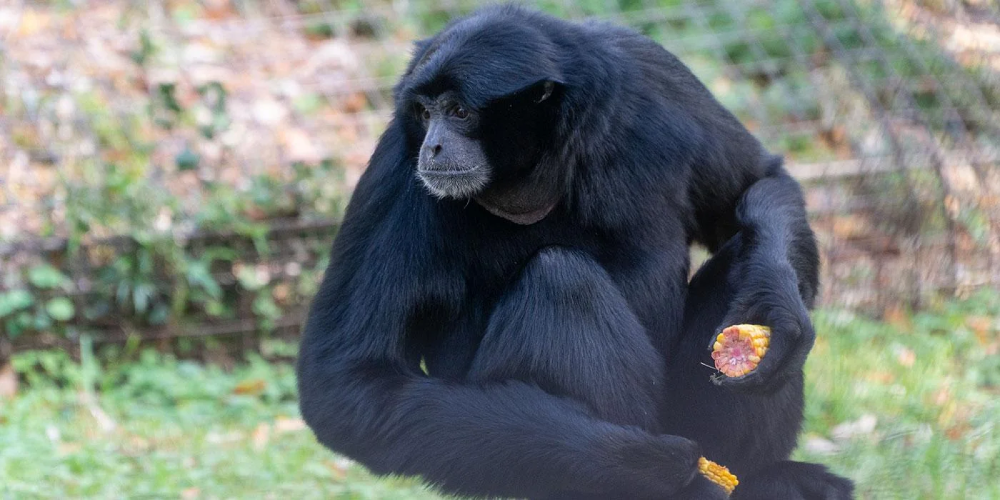In the dense rainforests of Southeast Asia, amidst the tangled canopies and verdant foliage, dwells a remarkable creature that captivates the imagination with its haunting melodies and enigmatic presence. Meet the siamang (Symphalangus syndactylus), a majestic and lesser-known member of the ape family, renowned for its distinctive vocalizations and unique social behaviors.
Discovering the Siamang
The siamang, also known as the “black-furred gibbon,” is one of the largest and darkest gibbons, characterized by its jet-black fur, long arms, and distinctive throat sac. Native to the lush rainforests of Sumatra, the Malay Peninsula, and parts of Thailand, these remarkable primates primarily inhabit the upper canopy layers, swinging effortlessly from branch to branch with unparalleled agility.

Physical Characteristics
Siamangs exhibit sexual dimorphism, with males being slightly larger than females. On average, males weigh between 10 to 14 kilograms (22 to 31 pounds), while females typically range from 6 to 10 kilograms (13 to 22 pounds). Their long, powerful arms are perfectly adapted for brachiation, the swinging movement used for navigating their arboreal environment.
One of the most striking features of the siamang is its inflatable throat sac, which serves as a resonating chamber for their distinctive vocalizations. When inflated, this sac amplifies the siamang’s calls, allowing their haunting melodies to resonate through the forest canopy, reaching distances of up to two kilometers (1.24 miles).
Vocalizations and Communication
The siamang’s vocal repertoire is truly remarkable, encompassing a diverse range of sounds including loud booms, whoops, hoots, and a series of melodious calls. These calls play a vital role in territory defense, mate attraction, and maintaining social cohesion within family groups.
One of the most iconic aspects of siamang vocalizations is their duet singing, a captivating display of synchronized vocalization between mated pairs. These duets often occur early in the morning, serving as a declaration of their bond and territorial boundaries. The complexity and precision of siamang duets have fascinated researchers for decades, highlighting the depth of their social connections and communication abilities.
Social Structure and Behavior
Siamangs are highly social animals, forming tight-knit family groups consisting of a monogamous pair and their offspring. Unlike other gibbons, siamang family units typically consist of only the parents and their dependent offspring, with no additional extended family members. This close family structure is crucial for cooperative behaviors such as territorial defense, foraging, and raising offspring.
Within these family groups, both males and females play active roles in parenting and territorial defense. Males are responsible for vocalizing and patrolling the group’s territory, while females primarily focus on caring for their offspring. The bond between mated pairs is strong, often lasting for life, and is reinforced through grooming, physical contact, and duet singing.
Threats and Conservation
Despite their remarkable adaptations and social complexity, siamangs face numerous threats to their survival in the wild. Habitat loss and fragmentation due to deforestation, illegal logging, and agricultural expansion are significant concerns, leading to the loss of critical forest habitat for these arboreal primates.
Additionally, siamangs are often targeted by illegal wildlife trade for their perceived medicinal value, meat, and as pets. The capture and trafficking of siamangs not only decimate wild populations but also disrupt social structures and genetic diversity within remaining populations.
Conservation efforts aimed at protecting siamangs and their habitat are crucial for their long-term survival. Initiatives focusing on habitat restoration, anti-poaching measures, community engagement, and sustainable land use practices are essential for safeguarding the future of these magnificent creatures and the rich biodiversity of Southeast Asian rainforests.
Conclusion
In the verdant jungles of Southeast Asia, the siamang stands as a testament to the beauty and complexity of nature. With its haunting melodies, intricate social structure, and remarkable adaptations, this enigmatic ape continues to inspire awe and fascination among researchers, conservationists, and nature enthusiasts alike.
As we strive to protect the biodiversity of our planet, let us not forget the plight of the siamang and other threatened species, and work together to ensure that future generations can marvel at the wonders of these ancient forests and the creatures that call them home.








